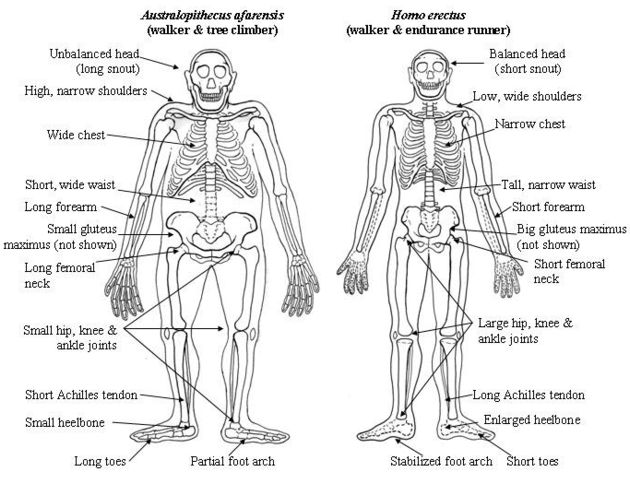Question
The diagram shows the skeletal systems of two ancestors of modern human beings.Write a 150-word report for a university lecturer describing the diagram and making comparisons where relevant.
Model Answer
Variations in the skeletal systems of two early types of human are illustrated in this diagram. Overall, we can see that australopithecus afarensis had a heavier body and much longer arms, while homo erectus was slimmer and had more developed joints.To begin with the upper half of the body, australopithecus afarensis had a much broader chest and waist than homo erectus, giving it a rounder appearance. The former had much longer arms and larger hands, which would have been useful for climbing trees.
As for the lower half of the body, we can see that homo erectus had proportionately longer legs and larger hip, knee and ankle joints. The feet of homo erectus were also smaller and more arched, with shorter toes. These differences meant that homo erectus was better suited to long-distance running.
In conclusion, we can see significant changes in the development of early humans from the diagram. Homo erectus is more similar to contemporary human beings with its long legs and arched feet. The physical differences are clearly related to differences in the lifestyles of tree climbers and endurance runners.
(183 words, IELTS 8.0-C1)
Why does this answer get an IELTS Band 8 score-C1?
Task achievement: The model answer selects only the most important information from the diagram and uses this to make several direct comparisons. The physical differences are clearly connected to the description of each creatures’s lifestyle, providing a very rounded answer. The length is sufficient.Coherence and cohesion: The model answer is divided into clear paragraphs with a logical separation between the body paragraphs. There is a general overview in paragraph 1 and a summary in paragraph 4. A reference link, the former, is used to avoid over-repetition of the names of the creatures.
Lexical resource: The model answer adds more vocabulary not in the diagram such as lifestyle, proportionately, suited, appearance and contemporary. There are also attempts to paraphrase such as wide > broad and endurance > long-distance.
Grammatical range and accuracy: The model answer uses comparative structures accurately. The temptation to list all the features in repetitive structures is avoided. A variety of grammatical devices are used to extend sentences, including with, which and -ing clauses.

No comments:
Post a Comment